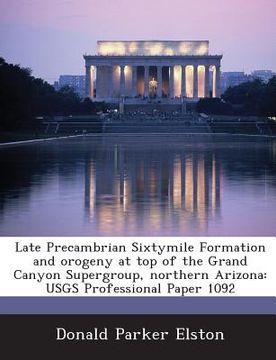Share
Late Precambrian Sixtymile Formation and Orogeny at Top of the Grand Canyon Supergroup, Northern Arizona: Usgs Professional Paper 1092 (in English)
Donald Parker Elston
(Author)
·
Bibliogov
· Paperback
Late Precambrian Sixtymile Formation and Orogeny at Top of the Grand Canyon Supergroup, Northern Arizona: Usgs Professional Paper 1092 (in English) - Elston, Donald Parker
$ 12.60
$ 15.75
You save: $ 3.15
Choose the list to add your product or create one New List
✓ Product added successfully to the Wishlist.
Go to My WishlistsIt will be shipped from our warehouse between
Wednesday, July 03 and
Thursday, July 04.
You will receive it anywhere in United States between 1 and 3 business days after shipment.
Synopsis "Late Precambrian Sixtymile Formation and Orogeny at Top of the Grand Canyon Supergroup, Northern Arizona: Usgs Professional Paper 1092 (in English)"
The Sixtymile Formation, a 60-m-thick red-bed unit at the top of the late Precambrian Chuar Group, crops out at three places in the Chuar syncline in the eastern Grand Canyon. Its base is marked by a transition from gray marine shale to red sandstone. The Sixtymile was deposited in the deepening trough of the north-trending Chuar syncline during and as a consequence of regional uplift, tilting, and large-scale block faulting. Folding to form the Chuar syncline occurred in response to faulting on the parallel-trending Butte fault, about 1 km to the east. About 3.2 km of structural relief was developed across the Butte fault, principally during deposition of the lower member of the Sixtymile Formation. Landslide debris shed from the upthrown block on the east constitutes a major part of the material in the lower member. Conglomeratic strata of the upper member of the Sixtymile were deposited after the last increment of subsidence on the Chuar syncline, indicating that deposition of the Sixty mile Formation spanned the time of the structural disturbance. The folding and faulting are part of a regional structural episode that here is called the Grand Canyon orogeny, an event that signaled the end of deposition of strata of the Grand Canyon Supergroup and the beginning of a long interval of erosion. The age of the Grand Canyon orogeny is estimated at about 830 m.y., inferred from an evaluation of maximum and minimum reset K-Ar ages reported for the 1,100-m.y.-old Cardenas Lavas of the Unkar Group. In age and structural style, the Grand Canyon orogeny appears generally correlative with the East Kootenay orogeny of British Columbia, which separates the Purcell (Belt) and Windermere Supergroups. By analogy, strata of the Chuar Group below the Sixtymile Formation are correlated with strata of the upper part of the Belt Supergroup, and conglomeratic strata of the Sixtymile deposited after the structural episode are correlated with conglomeratic strata of the Windermere that unconformably overlie the Belt.
- 0% (0)
- 0% (0)
- 0% (0)
- 0% (0)
- 0% (0)
All books in our catalog are Original.
The book is written in English.
The binding of this edition is Paperback.
✓ Producto agregado correctamente al carro, Ir a Pagar.

